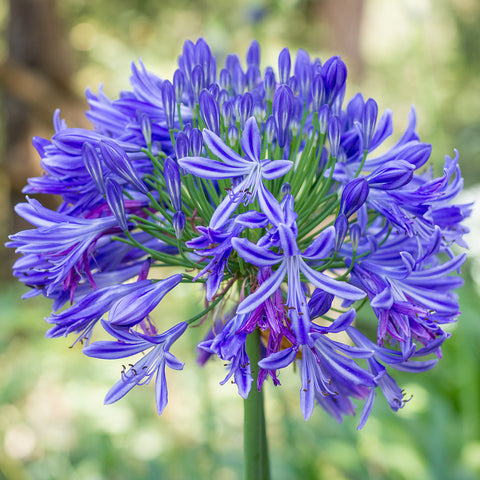Agapanthus Varieties: Choosing the very best for Your Landscape
Agapanthus Varieties: Choosing the very best for Your Landscape
Blog Article
Mastering the Art of Agapanthus Treatment: Essential Actions for Healthy And Balanced Development and Vibrant Blooms
In the realm of horticulture, the cultivation of agapanthus stands as a rewarding undertaking for those who look for to support these stylish flowering plants. With their striking blossoms and elegant vegetation, agapanthus has captured the attention of garden enthusiasts worldwide. However, attaining optimum development and dynamic blooms needs a nuanced approach that encompasses numerous necessary steps. From picking the right selection to mastering trimming strategies, the trip towards cultivating growing agapanthus plants is multifaceted and holds the vital to opening the full potential of these botanical treasures.

Picking the Right Agapanthus Variety

When selecting the ideal Agapanthus variety for your yard, consider aspects such as environment suitability, blossom color, and growth behavior. In addition, think about the environment in your region to make certain the Agapanthus variety you pick can prosper in your particular conditions. Comprehending the growth habit of different Agapanthus selections is important for appropriate placement within your garden.
Perfect Planting Problems
Taking into consideration the ideal ecological demands is essential for effective Agapanthus growing. Agapanthus plants are delicate to chilly temperatures and need to be shielded from frost throughout winter months.
To make sure healthy and balanced growth and vivid flowers, plant Agapanthus light bulbs at a deepness of regarding 2-4 inches and room them 8-12 inches apart. Mulching around the base of the plants aids maintain moisture and suppresses weed growth.
Watering and Feeding Tips
Preserving proper wetness levels and offering vital nutrients are key components in the care program for Agapanthus plants. When it involves watering Agapanthus, it is essential to strike an equilibrium. If overwatered, these plants like consistently moist dirt but are prone to root rot. Throughout the expanding season, water deeply as soon as a week, making sure the dirt is well-draining to avoid waterlogging. In hotter environments or throughout durations of dry spell, more frequent watering might be required to keep the dirt evenly damp. Nonetheless, minimize watering in the winter season to stop water logged problems.
Fertilizing Agapanthus is important for promoting healthy growth and respected flowers. Use a balanced plant food, such as a 10-10-10 formula, in the very early springtime as brand-new development arises. By adhering to these watering and feeding pointers, you can ensure your Agapanthus plants grow and generate dynamic, durable flowers.
Trimming Methods for Agapanthus
Trimming Agapanthus plants at the suitable times and with correct strategies is critical for preserving their wellness and advertising optimal growth and flowering. The optimal time to trim Agapanthus is in late winter or very early spring before new growth arises.
For flowered stems, wait up until the blooms have withered and afterwards trim them back to the base. This not just cleans up the plant's appearance however likewise encourages the advancement of new blossom buds. Deadheading spent flowers can also reroute the plant's power right into producing more blooms rather than establishing seeds. However, if you desire to accumulate seeds for breeding, leave some flowers to dry and fully grown on the plant.
Keep in mind to make use of clean, sharp tools to make specific cuts and lower the threat of presenting read what he said conditions. Agapanthus. Regular pruning will certainly aid maintain your Agapanthus looking cool and healthy and balanced while ensuring a plentiful screen of gorgeous flowers
Managing Common Pests and Diseases
After making sure correct trimming strategies for Agapanthus, it is vital to resolve typical pests and illness that can impact the wellness and vitality of these plants. Agapanthus this contact form plants are typically sturdy yet can still come down with particular issues. One typical insect that affects Agapanthus is the Agapanthus gall midge. This tiny, orange fly lays its eggs in the vegetation, leading to distorted development and flower buds that fall short to open. To fight this pest, trim and ruin any type of afflicted plant parts and take into consideration making use of insecticidal soap.
One more common issue is fungal leaf place, which offers as dark lesions on the leaves. To avoid fungal illness, make sure great air circulation around the plants, avoid above watering, and eliminate any type of contaminated fallen leaves immediately. Furthermore, Agapanthus plants can experience origin rot if they are grown in poorly draining dirt. To stop this, plant Agapanthus in well-draining soil and avoid overwatering. By being vigilant and taking prompt action against conditions and parasites, you can aid your Agapanthus plants grow and create vivid flowers.

Verdict
In conclusion, grasping the art of agapanthus care includes picking the ideal selection, supplying ideal planting conditions, proper watering and feeding, suitable trimming methods, and addressing common bugs and diseases. By complying with these essential actions, you can make sure healthy and balanced growth and vibrant blooms for your agapanthus plants. Remember to on a regular basis monitor and keep your plants to promote their overall health and long life.
To ensure healthy and balanced development and vibrant blossoms, plant Agapanthus bulbs at a deepness of concerning 2-4 inches and space them 8-12 inches apart. By following these watering and feeding ideas, you can ensure your Agapanthus plants flourish and generate dynamic, long-lasting flowers.
One usual bug that impacts Agapanthus is the Agapanthus gall midge. Additionally, Agapanthus plants can endure from root rot if they are planted in poorly draining pipes soil. By following these essential steps, you can ensure healthy and go balanced growth and vibrant blooms for your agapanthus plants.
Report this page